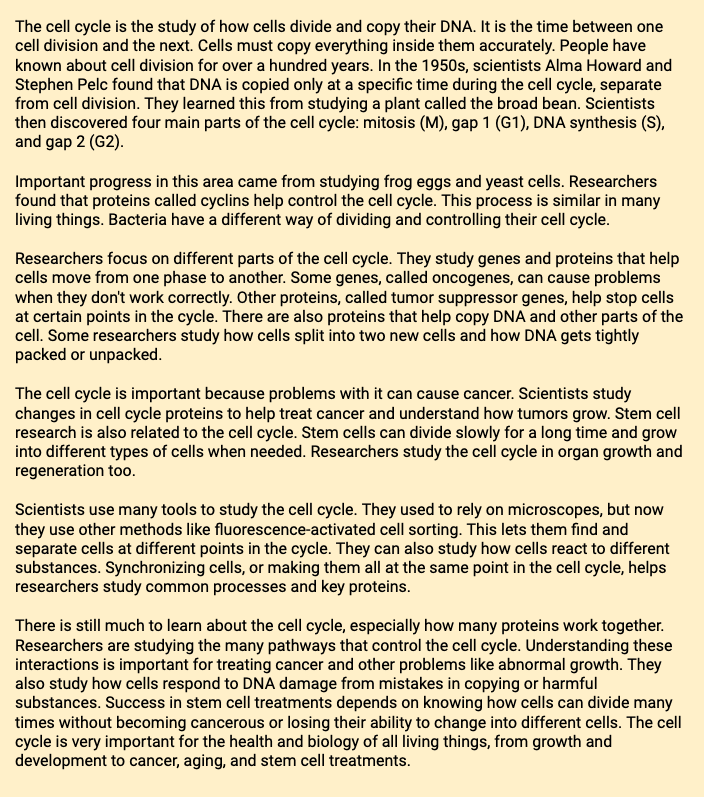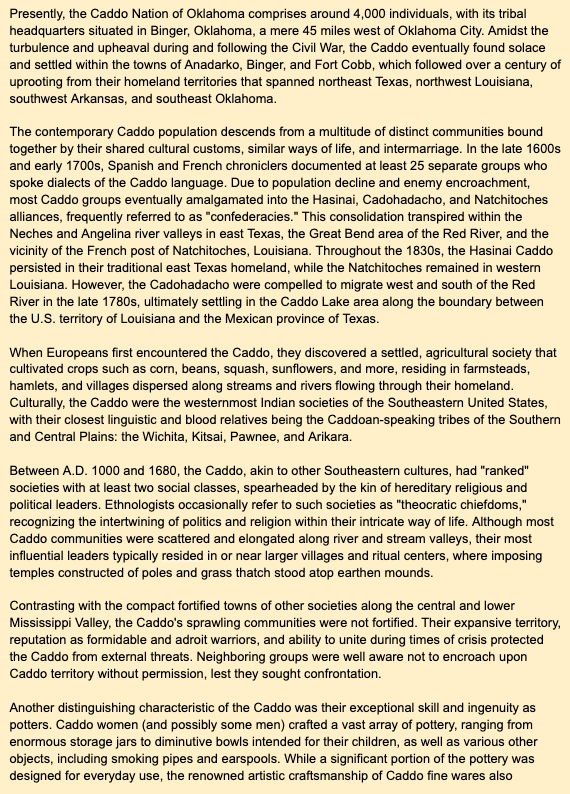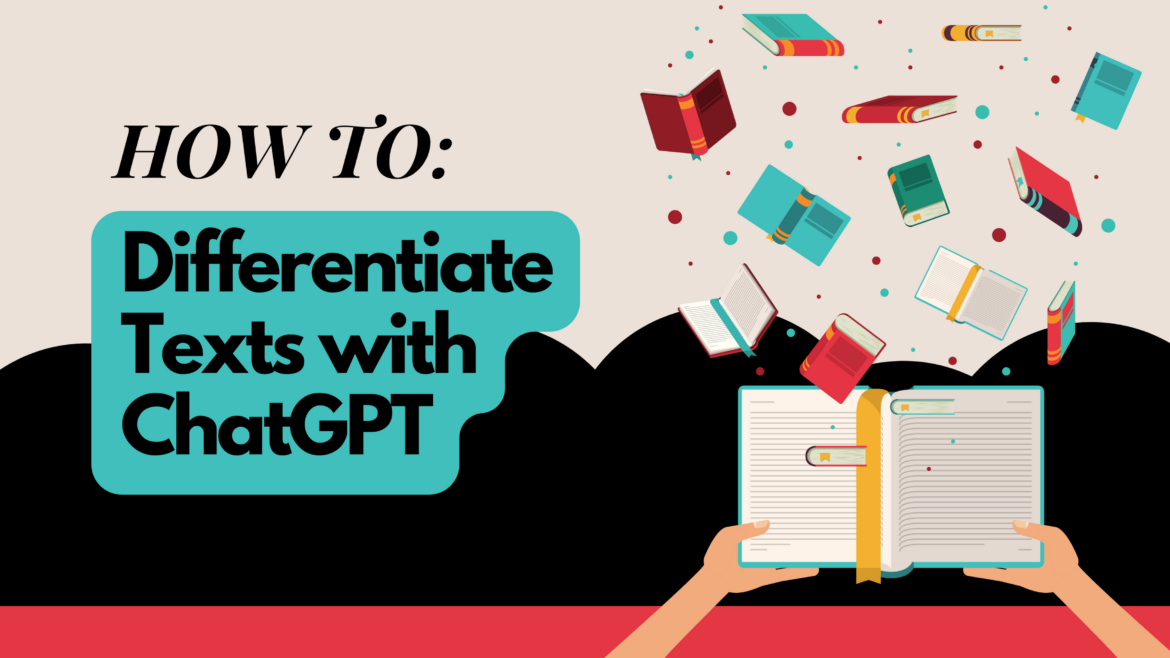Differentiation means providing a meaningful onramp to the content you are studying and supporting all students in skill mastery. We can differentiate the content, the process, the product, or the learning environment. Differentiating content, well, that is not quite so easy to do as some of the others. It could involve adapting or searching for adapted text that uses shorter sentences, fewer words with more than two syllables, and easier vocabulary. It could be adapting or searching for text at a higher reading comprehension level, including longer sentences, use of idioms, higher vocabulary word choices, and more complex sentence structures. Or it might mean making the text available in a different language so that it is more easily understood by the students. This can be quite time consuming. Let’s explore how we can use AI, like ChatGPT, to create differentiated text.
Prompting ChatGPT to Create Simplified Text
While ChatGPT does not have the ability to rewrite content just by us identifying the target lexile, we can create a prompt that will help ChatGPT rewrite the text so that it is at a lower lexile than the original text. To do so, we have to consider what we need changed. For our purposes, here are the criteria we want to include in our ChatGPT prompt to make this happen:
- Shorter sentences
- Simpler vocabulary
- Swapping out idioms for more concrete and direct language
By incorporating these in a prompt, we can have ChatGPT rewrite a given text. The prompt we will use is:
Act as an expert educator who has a deep understanding of [CONTENT OR SUBJECT AREA]. Rewrite the following text with these specific modifications: use shorter sentences; replace current content-related words with simpler vocabulary when possible; replace idioms with more concrete and clear language so that an English language learning student is more likely to understand. Do not bring any extra content into the rewriting unless it is critical to helping the student understand the original content. The final rewritten product should be about the same length as the original.
[PASTE ORIGINAL TEXT HERE]
For this example, let’s consider a 9th grade biology lesson on cell division. Your original text is from Scitable’s site and talks about the cell cycle and cell division. After we tweak the above prompt to include “cell cycle and cell division” in lieu of the [CONTENT OR SUBJECT AREA] placeholder, ChatGPT should generate text that is much easier to comprehend. Click here to view what ChatGPT generated for me. If the results aren’t exactly what you’re looking for, edit the prompt or click the Regenerate response button.

Prompting ChatGPT to Create More Complex Text
You may have students that are reading above grade level in which case you may need to differentiate the text to accommodate high reading comprehension levels. Here are things we want to include in our prompt to make this happen:
- Longer sentences
- Complex sentence structure
- Higher-level vocabulary
- Use idioms and pictorial language to reinforce concepts
By incorporating these items in a prompt we can have ChatGPT rewrite a given text. The prompt we will use is:
Act as an expert educator who has a deep understanding of [CONTENT OR SUBJECT AREA]. Rewrite the following text with these specific modifications: use longer sentences with complex sentence structure; replace current content-related words with higher-level vocabulary when possible; use idioms pictorial language to help reinforce concepts. Do not bring any extra content into the rewriting unless it is critical to helping the student understand the original content. The final rewritten product should be about the same length as the original.
[PASTE ORIGINAL TEXT HERE]
For this example, let’s consider a 4th grade social studies lesson on Native American groups in Texas, such as the Caddo. Your original text is from Texas Beyond History and is just one section on Caddo Fundamentals. After we tweak the above prompt to include “Caddo Indians in Texas” instead of the [CONTENT OR SUBJECT AREA] placeholder, we should be able to proceed with a text that is much more challenging. Click here to view what ChatGPT generated for me. If you’re not pleased with the results, you can edit the prompt or click the Regenerate response button.

Prompting ChatGPT to Translate Text
Your students may find it easier to read text written in their home language. ChatGPT is fairly robust when it comes to translating text. Prior to using this feature extensively, consider having a native speaker of the target language review the output so that you can have confidence that it’s correct and clear to the reader. For this, it’s simple – we just want to tell ChatGPT to translate the given text into a specific language.
Act as an expert translator who knows English and [TARGET LANGUAGE]. Translate the following text from English to [TARGET LANGUAGE]. Use the conventions and rules of [TARGET LANGUAGE] when translating.
[PASTE ORIGINAL TEXT HERE]
For this example, let’s consider a high school ELA class about to read Macbeth. Prior to reading, the teacher wants to give the students a summary of the play in order to help them later on, when they analyze the play and speak about the different conventions Shakespeare used. Your original text is from CliffsNotes and is a play summary of Macbeth. After we tweak the above prompt to include “Spanish” in place of the [TARGET LANGUAGE] placeholder, we should be able to proceed with a translated version. Click here to view what ChatGPT generated for me. Again, you can always edit the prompt or click the Regenerate response button to produce different results if you’d like.
Things to Keep in Mind
Level: Just because you have AI change the level of complexity of the text doesn’t mean that it has changed it to exactly accommodate your students. It might get closer, but it may not be perfect. You want the text to meet them at their cognitive load. If they are working below their cognitive load, then they will be bored. If they are working above their cognitive load, they will become frustrated.
Length: You may find that the text you want to edit is more than what’s allowed for a free account. You may have to edit smaller pieces of the original text, especially if it is several pages long, instead of doing it all in one go.
Content: If your text contains violence or other themes that go against the AI policies of use, it will not be processed. You will receive a message that it violates their standards. This may happen with texts that your students read, such as Romeo and Juliet, and other classic literature pieces due to violence, examples of bullying, etc.
Translation: If you are using the assistant to translate the original text, ask a native speaker to review the output for accuracy. Additionally, it might take the assistant longer to translate text than it would other tasks you prompt it to complete. If you don’t have an interpreter to check the work, you can copy/paste portions into Google Translate to gain some confidence as to its accuracy. I did not have a native speaker check the work that I shared in this post, so you could see the actual output unedited.
How Will You Differentiate for Your Students?
These are just a few ways that you can use ChatGPT to differentiate text to better support your students. What other ways can you think of? Share with us in the comments below. And, if you create an effective prompt, be sure to share with others and pass on the love.



